Text
DD2000 Proposal for Presentation
After I finish university I will start looking for work as a 3D artist, ideally one that specialises as a Vehicle Artist. I believe I am well suited to this role as I have a solid interest in anything mechanical, especially cars. I also believe there is a growing market for racing games as sim racing is gaining in popularity. I would love to apply my passion for anything with an engine into a long-term career. This would also have the benefit of incorporating my artistic skills I have picked up through my education. Because of these factors I have decided to focus my research for this presentation of vehicle artists and what their roles consist of. I will also be explaining my reasons for wanting to be in this role for my presentation.
I intend to get in contact with Vehicle artists already in the industry to gain valuable knowledge about what their day to day roles would be and what responsibilities they have. I want to research what kind of team culture some companies have to better understand where I should be aiming my portfolio. This would also be very helpful for me to gain insight into how my portfolio should be presented, so that I have the best chance to impress potential employers as much as possible. I would like to find out what things I could do to improve my portfolio and how to critically analyse my own work so that I can be constantly moving my abilities forward.
I would like to apply for companies that make games I am interested in, I believe this is where I am most likely to succeed. I’m hoping that my passion for vehicles will indicate that I’m motivated and in it for the long run. I would not be apposed to working from home, I think this would suit me nicely as I like to organise myself in my own space. This would also be good as it would save on a possibly long commute time and mean I could focus more on my role. I also would not be apposed t moving abroad, there are a number of studios in Poland, Canada and Sweden I would be interested in working for. CD Project Red are looking for new vehicle artists in Poland, Piranha Games are based in Canada and are making a new Mech Warrior game.
For my first job in the industry I wouldn’t mind where I worked really, as long as I am gaining industry experience. I will apply for many companies locally and in different parts of the country, to cast my net as wide as possible. I hope this increases the number of opportunities I have.
My presentation will focus on these core subjects, I will use the research conducted during this module to further my understanding of my desired role in the games industry. I’m hoping this will also give me insight in to where I should focus my portfolio efforts in the future.
0 notes
Text
XB2001 - Final Screenshots of Cathedral Level
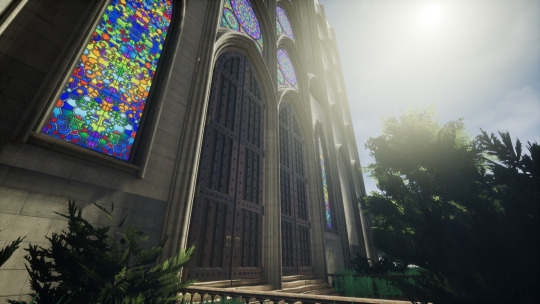
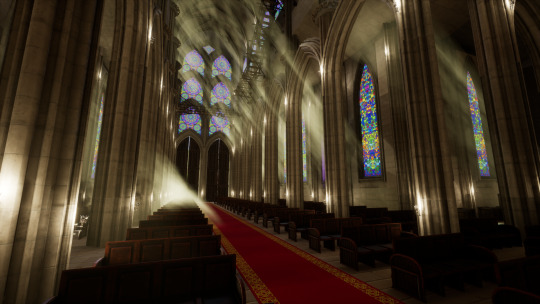
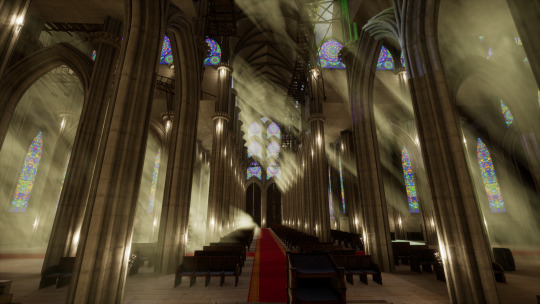
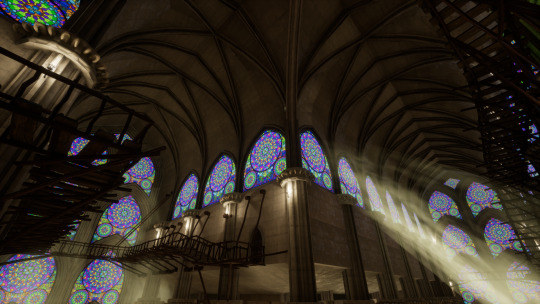
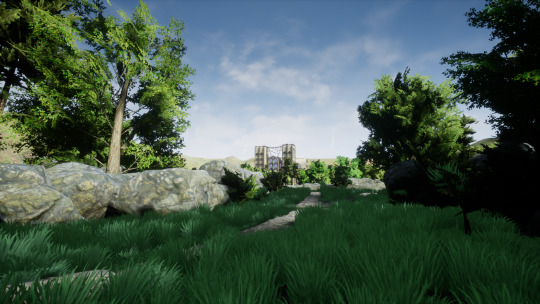
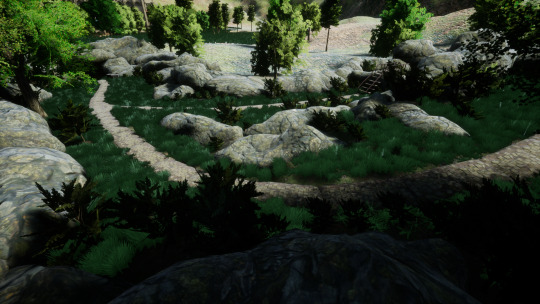
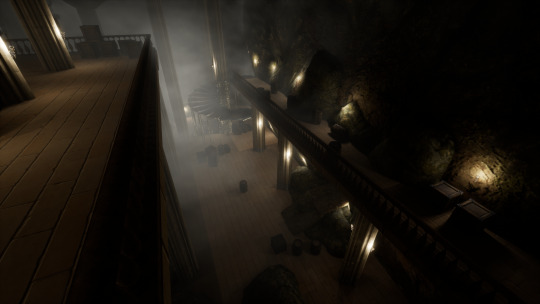
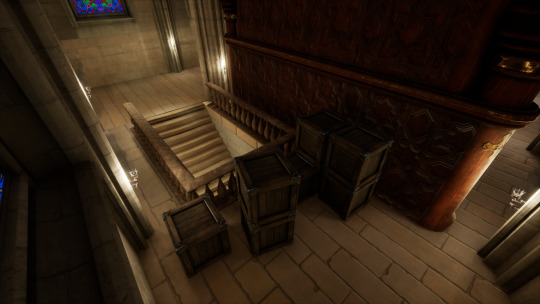
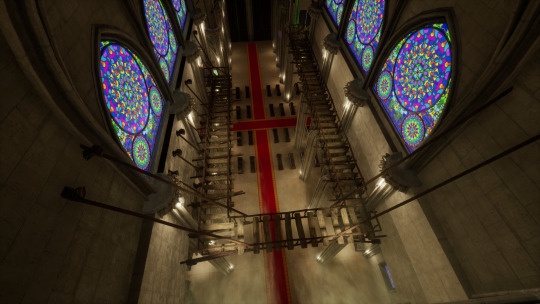
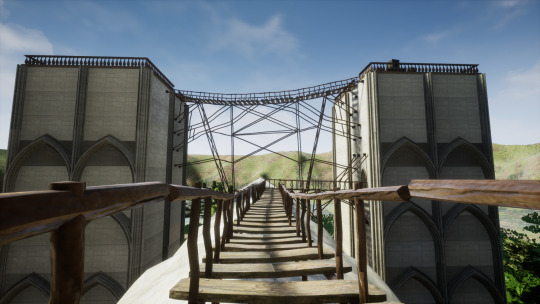
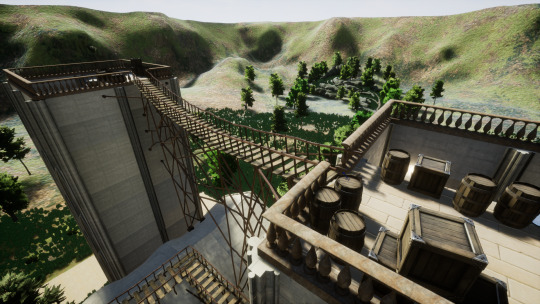
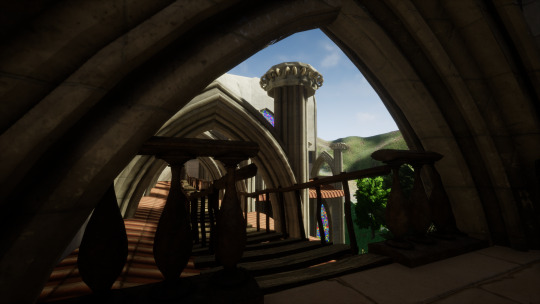
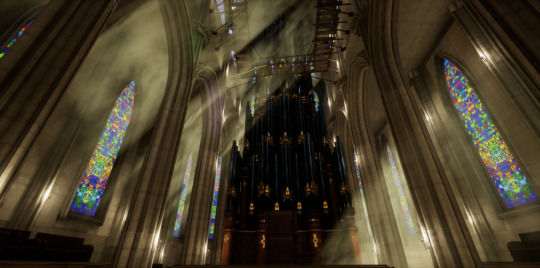
1 note
·
View note
Text
XB2001- What would I do differently next time?
From working on this level, I can say that the scale I set myself was the biggest challenge I had to overcome, if I were to build it again I would defiantly have set myself a smaller task. Saying that, the original goal was to create a huge sense of scale for the player. Leading them on a journey through different locations on towards a goal at the end. So, I think that the game accomplishes this quite well considering how much time I had to work on the project and having only a very basic understanding of how to do it.
I did want to set myself a big goal so that I would keep me motivated and interested knowing that it would be impressive at the end. This is by far the biggest level I have ever made and I’m proud of what I’ve done in a relatively small amount of time. So, in that regard it has been successful, but I can’t help feeling if I decided to do something smaller with less models in, I could have made environment pieces at a much higher quality.
Another thing I would do differently next time would be to organise a plan much earlier on, instead of spending a good few weeks researching buildings I wasn’t going to make. Deciding on what exactly it was I wanted to do earlier on would have freed up time towards the end of the project. If I had a clearer vision I would have been able to focus on making a more accurate block-out, making the models and textures more coherent.
If I had more time/organised myself better, I would have added more in terms of gameplay. My original Idea was to have a walking simulator where you would just walk around at environment, which I achieved. But I would have liked there to be more mechanics. Maybe a platforming section, and more keys that open several types of doors, rather than just one. But the level was already getting too big, I kept thinking about what the cathedral would be connected to, and what would that area contribute to the player’s journey. I originally planned there to be a maze with various ways through to enter the cathedral making the players experience different each time. In the end the basement was just two simple walkways, which served a purpose but were not as grand as I originally intended.
Overall, I am very happy with what I have achieved, I surprised myself with how much I could get done and this project was a big leap forward in my own development as a 3D artist. Next time would be more concentrated on the quality rather than the quantity of models. I feel I have proven my ability to make large scale modular environment pieces using various programs and implementing various techniques, even if at a basic level. I will use this experience I have gained from this level and learn from it in subsequent projects.
0 notes
Text
DD2000 Route to Industry Blog post 4
For my portfolio I’m going concentrate on making hard surface models. I want to get really into making 3D models look as good and immersive as possible. I want to show of my ability to make high poly bakes to normal maps using Zbrush and Substance. Which is a technique used in many companies throughout the industry. So it is an essential skill to master in order to make compelling detailed models, that aren’t as taxing on the system as pure geometry based detail on models.
I’ve had my work critiqued by some 3D modellers from Foundry 42, the team that made star citizen. Their advice to me on my Mech model was to add a greater sense of scale by using objects on my models that relate to human proportions. Things like handles and tools, things that the viewer can relate too. For my portfolio I’ve been told that poly counts are not important, there are no awards for the most frugal 3D artist. Joe mentioned that back grounds for my Mech model didn’t look so good in just black. He mentioned about making the back-ground relevant to the model you’re presenting. Such as making a warzone with smoke, blurred out to put the focus on the model. But still make it interesting to look at. I need to improve my rendering as well.
I’ve been getting into a rendering program called Marmoset Toolbag 3 and that has been producing much better lighting for my models than the built in software inside Substance Painter. It is also a program that’s used throughout the industry to show off professional looking models to employers, I’ve seen it being used many times on Artstation.com. So spending more time with the program to work out how to use it most efficiently would benefit me immensely. Another point that was raised in response to my Mech, the wear and tear of the Mech seems to be randomly spread throughout the model. This is because I used a Smart Mask supplied by Substance Painter, and didn’t go over it after. If I were to do it again I would use a Smart Mask in conjunction with using hand painting to make the mud, ware and tare more believable. I could build it up in areas that it would realistically settle, and brush it away in areas that it would be scraped off. Using reference pictures in regards to hand painting would also benefit me greatly. Getting first hand images of real world objects would help guide my decisions during the creative process.
Since I am aiming to be a Hard Surface Prop Artist/Vehicle Artist, I’ll be focusing my portfolio on making really well detailed Vehicles both from real life and Fictional. I’ll watch modelling tutorials specifically on techniques for hard surface models to gain valuable skills that I can apply to my own work. I also want to create my own PBR textures in Substance Designer and build my own library of material for use on later projects. Showing these materials in my portfolio will also be another feather in my cap to impress potential employers with. I’m not aiming to be a texture artist, so I would show the material in use with my models to give a deeper insight into its use.
As for 3D I also want to create a library of small modular 3D assets for use on various vehicles. There’s a number of Kit Bash’s made by 3D artist Tor Frick who has worked on games such as Fallout 4 and Wolfenstein. He uses a number of bolts, panels, vents and other machinery components interchangeably. This speeds up his work flow and makes his models look very cohesive and relevant within the world he’s been set. For me this would be very beneficial, and is something I should incorporate into the models I put into my portfolio.
As for subject matter, I would love to come up with my own designs for vehicles. I’m inspired by the world of diesel punk aesthetic of Crimson Skies. I feel I would do a good job of bringing the fantasy aircraft from these games to life. Bearing in mind the game came out over 15 years ago and the technology used for creating these models has improved dramatically. I would also like to include a very well-known real life Car into my portfolio, the Volkswagen Mark 1 Golf would be a prime example of a car I’d like to recreate. This would show that I could use references like photos and blueprints from real life, an essential skill in making vehicles.
I feel these models would interest companies like Slightly Mad Studios and Foundry 42 who are in the business of making compelling vehicles, if they were done to a high enough standard. I would have to show things like wireframe renders to show how my Topology worked, and show I was using my polycount effectively. I’d show my individual maps to convey that I had knowledge of how each texture map worked.
One of the most important lessons that I’ve learnt from talking Sean Barron was to not be worried about applying to studios that I’d consider to be way above my skill level. As he puts it ‘You have nothing to lose’. With this mentality I should send off my portfolio to many studios, regardless of the standard of work they produce. The most important thing to me would be to get a position in the industry, as being a 3D artist is one of the most common roles in a company. I’m confident that if I work hard at improving my skills over the next year I should be at a standard where I could obtain a job.
In companies such as Slightly Mad Studios, it is beneficial to have a passion for the subject matter as described in their job postings. In my cover letters I will provide with each portfolio, I will write about my passion for vehicles and machines. I’m hoping that this will show potential employers I’m a 3D artist because I love doing it. Hopefully this will prompt them to take a look at my portfolio and consider me for a position. It was mentioned in the talk done by Foundry 42 that cover letters do help a lot, and in order to get my dream job I need to make my chances of success as high as possible. It would be worth researching as much as I can about the company I’m applying for as possible in order to tailor my portfolio to them. This would be done by emailing current employees or reading interviews by members of team. This will hopefully show that I am committed to my profession.
0 notes
Text
XB2001 – Reflective Blog Post 1
Level Work in Progress Update:


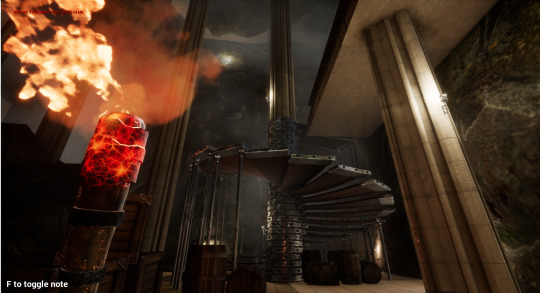
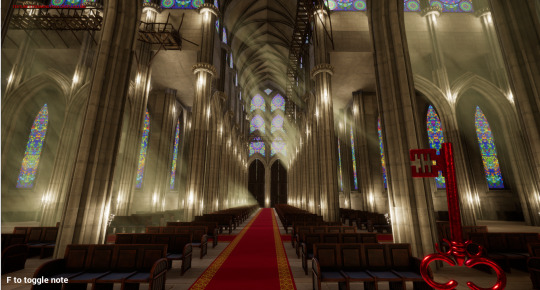
What went well:
Lots went well, I achieved a lot more than I expected to. I initially thought I’d bitten off way more than I could chew Using the Deform Bend tool in Maya I was able to make the straight pillars taper towards the top creating big sweeping lines. I’ve never been able to accurately use that before so that was progress for me. I based the length of the walls on the distance between the pivots of two pillars. I measured 24 Maya units, which was ideal because that could be divided into halves and thirds neatly.
A wall section I made only 6 Units long was used to make the door slot. I used a scaled down version of the ribbed vault and made it the correct shape to fit the door in. For the small door I too the larger front door and scaled it down and took out several the large iron bolts.


I made sure I was using the geometry of the previous models as efferently as I could, to maximize the amount of useful parts I had within the time given. I believe this strategy worked well it also meant that I was able to spend more time on other models that needed attention.
Another thing that went really well for me was the fog and god-rays. After following a short tutorial, I managed to create effective god-rays that worked well in the Cathedral Interior. I made tubes that were the same size of the windows and angled them towards the ground. In the material editor I used two cloud textures to pan over each other very slowly. This made the light look like it was catching dust particles as they swirled through the air.
As the player walked close to the god rays they would disappear making it look like they were getting less dense as you were walking towards them. This impressed me greatly, considering it took me less than 40 minutes to go from knowing nothing at all to implementing it in my game. I feel it really adds to the atmosphere and creates a profound sense of scale seeing the air move around the world.
What did not go so well:
I feel the biggest weakness of the project was probably that I made too much. While constructing the level I was asking myself “What would this be connected to?” and I would come up with bigger and bigger ideas of areas that could be adjacent to the Cathedral. I thought that being modular by nature it wouldn’t be an issue to keep adding to the level. I ended up making many objects that the player only sees briefly and thus probably wasn’t the most efficient use of my time.
Another aspect I could have done better was the roof, for a long time I was wondering if the Cathedral needed a proper roof with an inside and an outside. I eventually settled on spending my time else ware as the player wouldn’t be spending so much time above ground outside of the cathedral. Luckily my focus was on the Cathedrals interior which is where I believe it’s strongest.
0 notes
Text
DD2000 Route to Industry blog 3
My ideal job would be to work working as a 3D artist making Sci-fi or Real life vehicles and other hard surface models. I’ve always had a passion for anything with an engine, if I wasn’t making 3D models I’d be building model kits and fixing up old cars. I would draw Cars and Plans a lot as a kid, so I guess subconsciously I’ve been looking for a way to channel that enthusiasm into something creative.
Based on my 3D models I’ve made so far, I feel my skillset is leaning more towards hard surface modelling. I like to use physics based rendering to recreate realistic textures, rather than hand painting. I feel there is a lot of potential in PBR and I’ve barely scratched the surface of what can be done. Although Photoshop is an important tool and I used that to support my textures I’ve made in Substance rather than exclusively use it for texturing.
I think I would rather work on Vehicles and Hero assets that I can spent a lot of time on and make look amazing. I feel like I understand the rules of designing vehicles and other hard surface objects based on my interest and research over the years, rather than organic environment pieces. Now that I’ve tried modelling both, I found myself having a preference for hard surface models.
I’ve been talking to Sean Barron who works for Slightly Mad Studios, the company behind the Project Cars series. Sean works as a vehicle artist remotely from home. Each day he communicates with his lead artist that sets him his job that he needs to do that day. He can pick what work interests him the most, unless there is anything that needs to be done urgently.
“In general, it is quite free-form compared to many productions. My general day would go like this:
- check the work forum. see what new posts there are and what interest me - I don't have to check everything but I like to keep up-to-date on the general production of the games (some people check nothing except what is related to their own work)
- if I finished a task the day before, ask the Vehicle Art Manager or one of the Lead Artists what I can do next (rarely is there a list of tasks pre-assigned, I usually just ask the manager and he will know what I'm working on next).”
Once his day is over he uploads the work he’s done to a company file management system. He cuts down on travel times and gets to concentrate on his work more.
For me this would be an ideal situation as I feel I could organise myself at home to have an efficient workflow. Some companies such as Slightly Mad Studios have set themselves up to operate with many remote workers and it seems to be working out pretty well for them. As Sean has mentioned, his interview was all done over Skype, he’s never visited the main offices in London so literally all aspects of his work are done remotely.
There are pro’s and cons to this, he mentions
“ Working from home is many peoples' idea of a nightmare. Whether it is because of cabin fever, a sense of isolation, a lack of drive/self-control/motivation... or any combination of the above! Many freelance workers mitigate some of this by working in coffee shops or whatever but sadly this is slightly harder with a proper AAA-esque game development job like this simply because you would need a very powerful laptop to be able to do that (we're handling 3ds Max files with 200,000 triangle vehicles in them + all of their LODs, DirectX materials etc, but also you have to build and test the game often which requires a tonne of hard-disk space).”
From this I can deduce that careful consideration is necessary when approaching companies and it pays to do as much research as possible into their inner workings.
0 notes
Text
Modular Cathedral Video
A mostly finished version of the level I made.
https://www.youtube.com/watch?v=_6VKatQUckM
3 notes
·
View notes
Text
DD2000 - Rout to Industry Blog.
Today I spoke with Joe Neville who is a vehicle artist from Cloud Imperium about what would make a good portfolio applying for a vehicle artist role. I received good useful feedback about my mech I made that I can implement into my next 3D project. He has made very impressive sci-fi vehicles such as the MISC Razor.

I was also introduced to a number of new artists to research such as Tor Frick who is a Sweadish Vehicle Designer that has worked on Fallout 4. His work with the Fallout Tank is very impressive.

Another very talented artist is Nathan Dearsley from Manchester, he works for Cloud Imperium. AEGIS Dynamics Retaliator is an example of his work for the company.

I was intruduced to a series of models/art style called Maschinen Krieger.

0 notes
Text
DD2000 - Rout to Industry Blog. 3D Artist Reseach
I’ve been researching 3D Artists who work both freelance and in house for various game companies. I’m particularly interested in Vehicle Artists as one day I hope to make that my profession. While searching 80lvl I came across an article from an Artist called Karol Miklas.
https://80.lv/articles/vehicle-production-for-games/
He’s been in the industry since 2013 and has worked on games such as: Dying Light, Cyberpunk 2077 and PLAYERUNKNOWN’s Battlegrounds. The article goes into his principles oh how vehicles should be created, taking into account their purpose their manufacturing techniques and style.

He talks about his workflow too:
“Tools I use are Blender (for 3D, but also baking maps), Photoshop and Substance Painter. These three are completely enough to make stunning 3D work, but that’s not all…
I also use my camera for gathering references and sometimes photo-based textures, vectors for logotypes or more complex graphic designs… and a ballpoint pen for drawing, whether I need to sketch out some schematics or design ideas”

He mentions numerous times about how important it is to get good reference images, using them to guide the creation of the model.
Another 3D Artist I came across while searching art station was Antonis Karidis who has worked freelance for 777studios ,1C Publishing EU, Ubisoft and GMT games. He’s produced 2D art using his 3D models on covers for the Magazines Britain at War, Flypast and Aeroplane.

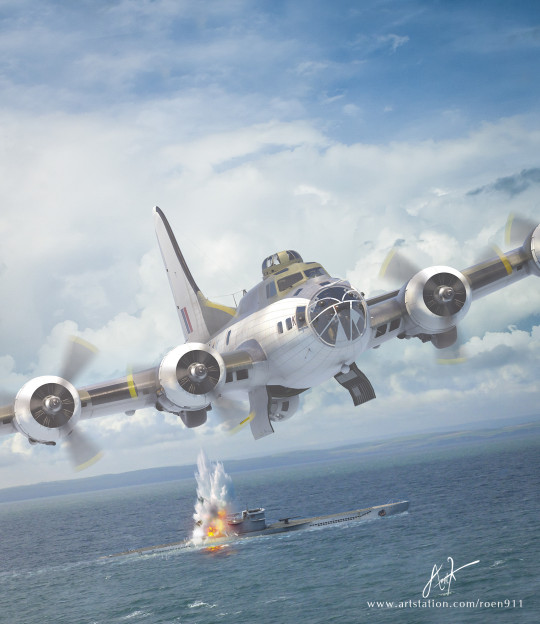
These are obviously very talented individuals, but they too had to start somewhere. I’ve noticed a role that would be perfect for what I’m aiming for, it’s for a company called Slightly Mad Studios based in London. They are responsible for the Project Cars franchise. The position is for a 3D Vehicle Artist that works remotely. The day to day tasks include:
Modelling aircraft/car exterior (high detail, 100k+ polys).
Modelling aircraft/car interior (high detail, 60k+ polys).
UV mapping (unwrapping meshes).
Modelling low poly LOD versions of high detail meshes.
Daily progress reports in our central forum.
Skills with textures, animation, skinning and setting up data / runtime files a distinct advantage
1 note
·
View note
Text
XB2002 - High Poly on Sketchfab
The Vulture / Mad Dog is a heavy Clan Omni Mech used for long-range indirect fire support, introduced in the year 2963. For this livery I took inspiration from the Clan Ghost Bear Vulture that is on the MechWarrior 2: Mercenaries Expansion Pack cover.
This model was made for a university project. The goal was to bake a high poly onto a normal map with the low poly under 30,000 polygons. form the MechWarrior BattleTech Universe. I made the low and high poly models in Maya, then added detail to the high poly in Zbrush before baking that onto a normal map in Substance Painter.
Models Can be found at:
https://sketchfab.com/models/1ffd084ac2714f178f034e0b7f2757bc
https://sketchfab.com/models/832e624420d34ff697ae9facbab3861b
I did not make the clan logos. All credit for those goes to Punakettu who is a fantastic artist. You can find his work at https://punakettu.deviantart.com/ His work played a role in inspiring me to make my own Mech for the MechWarrior from the BattleTech Universe.





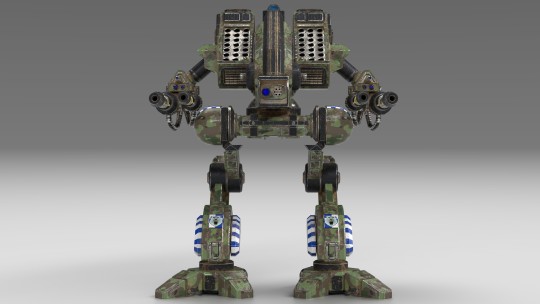
0 notes
Text
DD2000 - Route to Industry Blog post 1
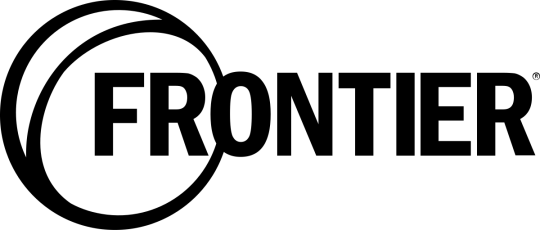
After my discussion with Alex about what I might want to do as a career following our last lesson. I have decided that my skills lie in making 3D objects from concept art and pictures. I’ve decided to pursue a career in 3D art. I would ideally like to be a 3D Prop/Environment Artist for a games company when I leave Futureworks. I’ve been looking at various studios in the UK and Europe. One that I came across that I am particularly interested in is for a company called Frontier Developments based in Cambridge.

They have a job opening that I found on Indeed.co.uk for a 3D Props and Vehicle Artist working on their game Elite Dangerous. I fell this would be a dream job for me as I am very interested in vehicle design and 3D modelling. The job posting states the essential qualifications and experience required to be accepted for the job: In the job requirements I am expected to:
Key Accountabilities
Communicate visual ideas within the team quickly, through well-honed drawn skills, both digitally and in traditional media
Create and maintain fully textured 3D prop and modular assets, and to be undaunted working with large-scale locations
Work with fellow artists to maintain the highest-quality throughout the game world
Work with the Designers to ensure environments are unified in both fidelity and play experience.
Person Specification
Ability to appreciate, respond to and provide constructive critique
Desire to collaborate to create an immersive game world
A great work ethic to work hard, play hard and inspire colleagues with quality
Show initiative and be proactive to get the best from our powerful Cobra engine
Good communication skills both verbal and written.
Solid skills in hard surface modelling, preferably in Maya
Strong grasp of real-world machinery, weapon function engineering; the kind of knowledge which produces authentic science-fiction hardware
Great understanding of proportion, scale, perspective, lighting and colour
Experience with PBR and a real-time engines
Experience in working on a game team either commercially or on a completed mod with multiple releases
Proven skills in photo-realistic surfacing using tools such as Substance or Quixel
A keen eye for spinning narrative and life into the environment
Thorough knowledge of and experience with Adobe Photoshop
Strong traditional art skills.
I would need to work in a studio that has shipped a game in order to gain the necessary experience before applying for such a job. I would ideally have to get a internship as something related to being a 3D Vehicle/Prop Artist as my entrance to the industry.
1 note
·
View note
Text
XB2002 - Next Gen Asset - My progress so far.
It’s been a while since the last post I made on this model, a lot of progress has been made but there is still a fair amount of work to do. I’ve got to a point with the High-poly where I can start making a Low-poly version. My poly limit for the low poly is 20,000. I’m making the model as one half the mirroring it over to the other side so really my poly count limit is 10,000. From the master model I’ve copied all parts over to the high poly and cut edge loops into every hard corner I want to make and leaving out for the curves.

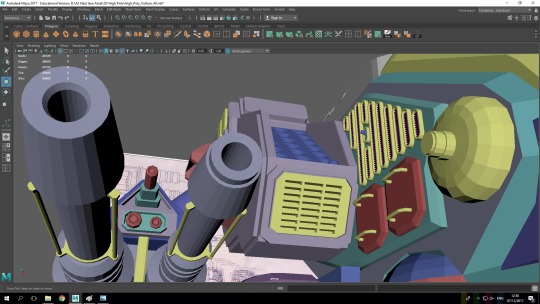


I’ve added the 3rd person character from UE4 and measured his height in Maya using the ruler tool. Then I researched the average male height (1.76m in the US) the found the height of the Vulture mech from the Battletech universe (12m, though there are conflicting sources) found out how many times i needed the mech to be bigger than the reference human. The result is that this mech was surprisingly, much bigger than I expected. The human looks like it would comfortably fit in the cockpit so I’m guessing it is correct.


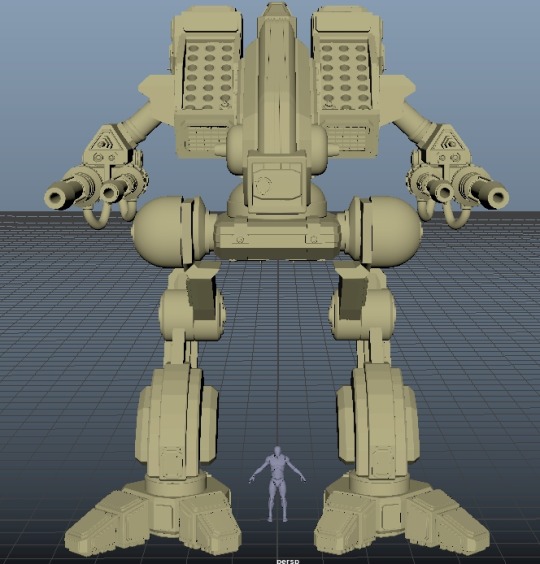
From this High poly model, now that it’s in scale to UE4, I’m remaking some of the more complex parts to fit into the poly budget.

Once I’ve done this, It’ll be ready UV then export as an FBX into Substance painter, depending on time I would also like to add damage to the high poly model. Maybe melted areas of armor from laser hits and broken metal areas from missiles. Looking forward to uploading some really nice renders of it when it’s complete.
0 notes
Text
Research and Development for Essay
For this essay I have chosen the ‘Design and Seriousness’ topic and will be calling my essay “An investigation into: The importance of a game’s accuracy to its source material”.
I want to talk about the importance of historical accuracy in games, as I think it’s very interesting how many games treat the subject differently. From simulators that want to recreate very specific elements of real life, such as racing simulators taking every details of the cars feel and handling. I’d like to find out the reasons why a certain line is drawn where developers decide what to include in a game and what should be left out. I hope that researching this topic will force me to think more about how games are made and what their influences are.

What made me think about this topic first was the assassins creed games and how, at least on the face of things are very historically based. But after closer research there are many historical inconsistencies, yet it’s still a very enjoyable game that immerses the player enough to convince them they really are in that time period, and they really playing as a real character. It would seem the sweet spot really is somewhere between hard historical facts and pure fantasy, even when making a historically based game.
http://www.eurogamer.net/articles/2014-07-05-its-not-historically-accurate
I looked at several articles on sites like Euro Gamer which I thought were very interesting, I liked how it talks about many historical misconceptions such as:
“Did you know, for example, as I didn't, that academics only recently started to accept there were actually really quite a lot of Viking women roaming around pillaging? And that they probably fought just as much as the men?”
I found this very interesting as it shows that even history taught at schools is widely different to how history can be perceived by recent findings. I’ve never seen this kind of finding portrayed accurately in games before, personally I think it would be a very interesting avenue to explore. As mentioned in New Normative, this article discusses how games are wildly different from the realities in history, and for a good reason too.
http://newnormative.com/2017/05/04/almost-no-one-actually-wants-historical-accuracy-games/
As Jay Castello mentions “That’s why COD: WWII, like any game loosely set in a historical period (or fantasy world “based” in history) is not intending to be accurate. It’s intending to be engaging. And you know what’s engaging? Well, zombies and respawning and killstreaks and all the other ubiquitous historical inaccuracies. But also female characters.”
I really like this article as it cut through to same point that I would like to argue in my essay. That games made for entertainment purposes are inherently going to be angled to goal of immersing and entertaining their players more so than worrying about historical inaccuracies. Even if the games is historically based, it needs to put its function of being entertaining first, and its form of a historical setting second.
Another game that I thought handled its historical setting very well was Empire Total War. It gave the player a lot of control to rewrite history in various scenarios. A lot of the possible events that happen in the game are a result of players actions, but are still believable and don’t break emersion. I would like to research exactly where the designers decided where to include historical accuracies and where they let the player’s actions take over. Games aren’t the only things that take creative liberties over their source material, movies are famous for being wildly different from their book counterparts despite portraying the same story. For example, The Lord of the Rings books written a long time before the scripts of the movie were, you can see a lot of adaptations that are in the movie to make it a more cohesive viewing experience. As show in this interesting article on the Lord of the Rings Wikia page:
http://lotr.wikia.com/wiki/Tolkien_vs._Jackson:_Differences_Between_Story_and_Screenplay
0 notes
Text
XB2001 Assignment 2 Project Video
youtube
Rabbit Friends - Environment Art
4 notes
·
View notes
Text
XB2001 – Assignment 2 - Blog post 4 - Research and Development
Before I started each piece, I wanted to gain a thorough understanding of how to go about making the assets. As I’ve never made a modular house kit before, or anything modular for that matter, I thought it would be best to research by watching videos of how the pros do it. The first video I watched was from a GDC conference by Bethesda.
youtube
I found this very helpful for making modular assets, as it taught me to keep to strict sizes and make sure pivot points are in the same places. This helps the level designer use the kit to it full potential as apposed to getting confused with what goes where.

For the bridge I researched pictures of gatehouses for from European castles in the late middle ages to gain a basic understanding of the architecture used at that time for this purpose. One bridge I looked at was Monnow Bridge in wales.

This was because the time period for the game was also in the late medieval era and I wanted the buildings to reflect this. It also needed to make efficient use of the rest of the house kit, so I made it the right size for 4 roof pieces to fit on top. The archway also needed to be wide enough for the player to fit through with ease.

I researched pictures of late medieval houses and decided on how best to cut the houses into modular segments. I looked at how other 3D environment artist have made their kits and tried to emulate the way they structured their work as best I could. I liked this village in Germany, the way the building are clearly segmented helped me a lot.

https://sketchfab.com/models/3d6fdf3d714148f882a044d70c7abdab
Before this project I haven’t worked with many transparency textures before and needed them to make the leaves for the trees. I preferred this technique as I knew it was a standard industry to make the trees this way as apposed to make individual leaves. This would of course save massively on poly count. I watched a few YouTube videos on how to make transparency textures work. This was the most useful one.
youtube
Overall I think my researched helped me a lot as I learnt new techniques and not a I feel a lot more capable of making cohesive modular environment kits.
0 notes
Text
XB2001 – Assignment 2 - Blog post 3
The next part of my tole was dedicated to making a modular house kit that could be interchanged into a number of different configurations. I needed to make sure all of the house pieces could fit next to each other, so I set the dimensions to all the wall panels to 200 by 200 Maya units. I then made the roof panels the same width, so they would fit on perfectly. The A-frame would be the right size to fit in-between the roof and the wall.

I made 6 different wall panels all the same size but all with the same dimensions. four of the wall panels had different wooden beam layouts, this would ensure that the buildings didn’t look too repetitive. I made a window panel that has a transparency texture, so you can see through the building.

This would also let light into the buildings aiding the player to feel a better sense of space while inside.
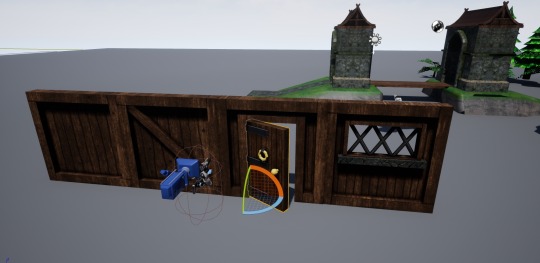
I also made a wall piece with a door so that the player could enter and exit the buildings, this was done by taking the original basic door piece and cutting a hole in it. Then making support beans for the door. I made sure that it was wide enough for the player to fit through.

After this complete I lined up a cube that would fit inside the frame and started to make a door from these dimensions. I added details like brackets for the hinges and a knocker, as well as a door knob. I textured these in gold to make them stand out so that the player’s eye would be drawn to it and see it as a target.

I made one wood texture and saved it as a smart material in Substance painter, this enabled me to keep a consistent look to the asset pack. I did the same for the grass texture and kept the same rock textures throughout all of my environment assets. I found this very useful as it meant I could work more quickly and efficiently without the hassle of recreate the same textures over and over again.

The trees were an interesting exercise for me to familiarize myself working with transparency textures, I found it difficult to get them to work at first. It seems Maya is not properly set up to handle transparency masks without adapting it in some way. The back of the textures were clipping through to the front and causing the trees to look very strange.

I rectified this problem by plugging the textures into unreal and moving the transparency map from ‘opacity’ top ‘opacity mask’. Then by setting the blend mode to ‘Masked’ and turning on the ‘two sided’ option on, this fixed my problem and I am not a lot more competent with using transparency textures on my models.

For the oak tree I made it out of a trunk, a branch and a set of leaves. Once UV’d I duplicated these pieces over and over again until the asset looked like a fully grown tree with lots of branches and leaves. All done with the minimum amount of pieces, allowing me to use smaller textures and optimize the game better.

0 notes
Text
XB2001 – Assignment 2 - Blog post 2
In my role as an environment artist I was tasked with making the landscape and a number of environment assets. The most important of these would be the bridges. Without which the player could not progress through the level, so they had to be functional and fit in with the aesthetic of the game. I went with a medieval style gatehouse for the design of the bridge. I researched later medieval gatehouses and took architectural ques from that.

For the roof of the gatehouse I used the modular roof from the house kit that I made. I worked out that scaled down you could fit 4 along the gatehouse roof transversely. I then book-ended these with the wooden A-frame again from the house kit. This complete the gatehouse.

Through play-testing we found that the bridges were often at different heights and this made them look dysfunctional. To rectify this, I wanted to make sure that the bridges are both level with each other. This would also make sure that when the bridge lowered, the player could move to the other side.
I needed to make a universal modular platform for the bridges to fit on to. This platform would also need to fit with the path segments to create a seamless transition between the two. My solutions was to create a simple ramp with long skirts that would go through the base scene. This would insure that it could be places on uneven terrain and not look too out of place, as well as providing a flat platform for the gatehouse and bridge.

Another part that would be essential for gameplay would be the pressure plate, the function of this is so that when enough of the rabbits sit on top, this would trigger the first bridge to lower. I decided on a circular shape as this would make it possible for the rabbits to approach from any angle. I made it dipped in the middle of the central piece so that it was more intuitive for the player that something is meant to go on top. This is further indicated by the circle that is in the middle of the pressure plate.

Things like rocks and trees were also very important, I made a selection of rocks and a cliff to give more control to the level designer. These could also be used to hide edges of assets, for instance if the edges of the bridge platform are visible, these rocks and boulders would go great at the bottom of the river bed to blend in with the scenery.

Next was the path segment, I needed a more detailed path for the player to walk on. This would also be used to flatten out terrain and make a smoother journey for the player as they moved between the challenges.

Through play-testing I found that the flat path segments caused Z-flickering, so I rounded out the edges so the path segments cut cleanly into each other.

0 notes